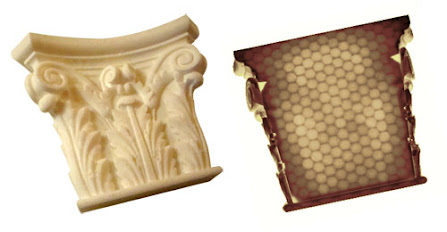 |
| click to enlarge | www.mapsofpa.com |
This 1859 map of Pittsburgh, Pennsylvania shows how the Allegheny River (at the top) joins the Monongahela River (on the bottom) to form the head of the Ohio River. This point was valued even in America's colonial days as strategic for both trade and military defense, and today it is often referred to as "The Golden Triangle."
 |
| Fort Pitt | www.fortpittblockhouse.com |
When the French established Fort Duquesne on the triangular spit in 1754, the British sent troops led by 21-year-old Major George Washington to serve an ultimatum and retake the land. Washington was defeated by the French, as was General Edward Braddock, in 1755.
These were early battles of what became known as the French and Indian War (1754-1763), so called because Native Americans sided with the French.
The French eventually retreated from Fort Duquesne, burning it to the ground as they left. The English, led by General John Forbes, reclaimed the point and Forbes named the area around it "Pittsburgh," in honor of William Pitt the Elder, the Prime Minister.
Fort Pitt (shown above) was built between 1759-1761.
 |
| mybonnie.wordpress.com |
George Washington, who surveyed more of the United States than most
Americans realize, surveyed much of the land in the vicinity of Fort Pitt
with the aim of parceling it to French and Indian War veterans.
 |
| Pittsburgh Then and Now | Arthur G. Smith |
Now, you would think that with a history like that, the Point — as it became known — would be prized and preserved. But that was not the case. By the mid-1800s, the area was an industrial site. The 1908 photograph above shows that there was a huge logging trade along the Monongahela, and that the heavy industry of the city was already establishing Pittsburgh as a notoriously smoggy, dirty place. In fact, well into the 1940s and 50s, Pittsburgh was so dark with smog that it was not unusual for streetlights to burn throughout the day, and for traffic police to wear masks.
 |
| www.brooklineconnection.com |
This 1948 view shows railroad tracks leading to the Point and water in which one wouldn't want to swim.
 |
| www.post-gazette.com |
Then in 1945, Pittsburgh elected Democratic Mayor David L. Lawrence, a remarkable man. Over the course of four consecutive terms, he forged alliances with Democrats, Republicans, bankers and industrialists, and through his own vision and determination created an urban renewal that the people of Pittsburgh called "The Renaissance." It took more than two decades of work, but today the Point looks as you see it below.
 |
| click to enlarge | shutterstock |
 |
| www.politicspa.com |
My very first job was in "Gateway Center," and I looked out from a window where there's a red "X." By that time, Pittsburgh was working hard to clean its sources of pollution, though people who hadn't actually visited there still referred to it as "the Smokey City." Eventually Pittsburgh's steel industry died (the tallest building in this photograph is the U. S. Steel Tower), and Pittsburgh became a center for computer technology.
 |
| www.riverlifepgh.org |
Today one can visit Point State Park and walk along inset granite markers that delineate the foundation of Fort Duquesne. Then at the very tip of the triangle is a basin with a 150-foot (46 m) fountain.
 |
| www.tripadvisor.com |
The interesting thing about that fountain is that it's fed by a fourth, subterranean river that runs approximately 54 feet below the city. Water is pumped up from the river, which is a remnant of ancient glacial flows.
 |
| click to enlarge | the course of the Ohio River | en.wikipedia.org |
 |
| Pittsburgh History & Landmarks Foundation |
Three Rivers
.



























































